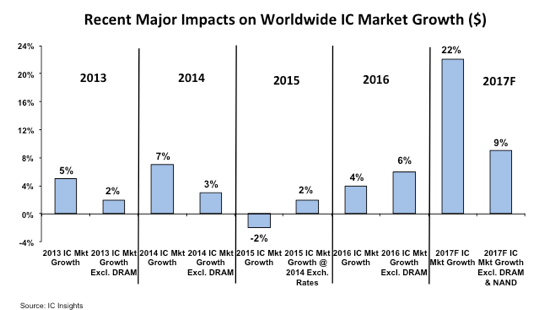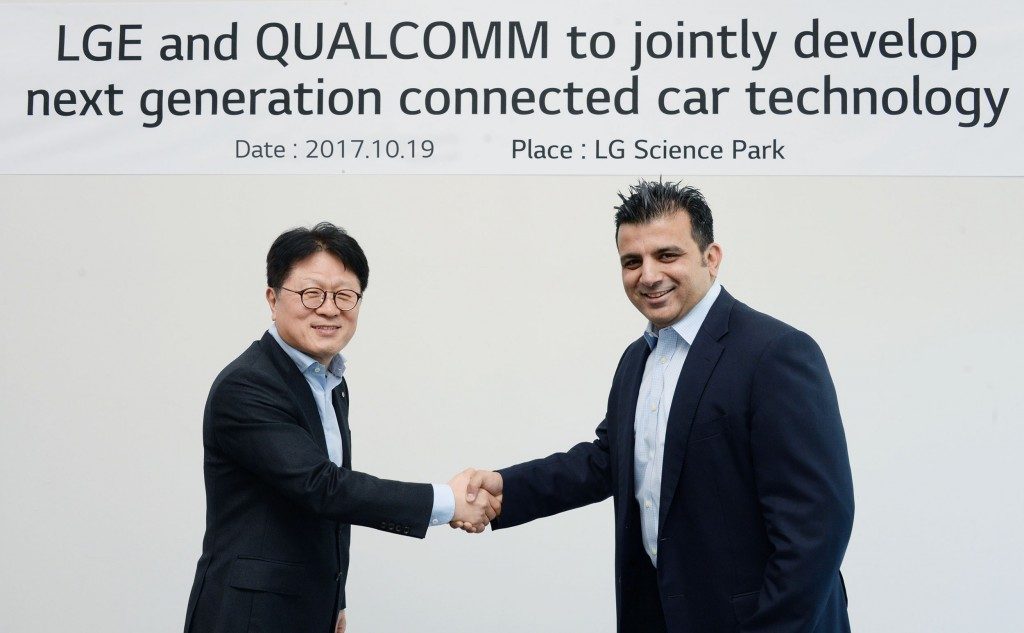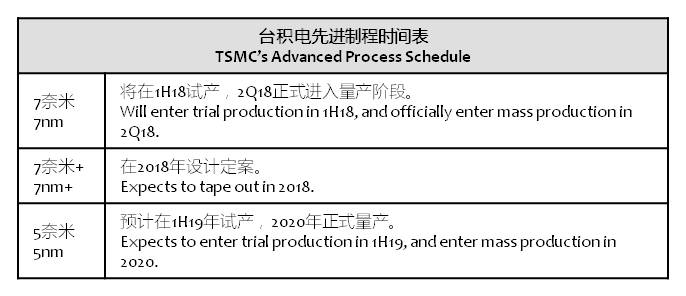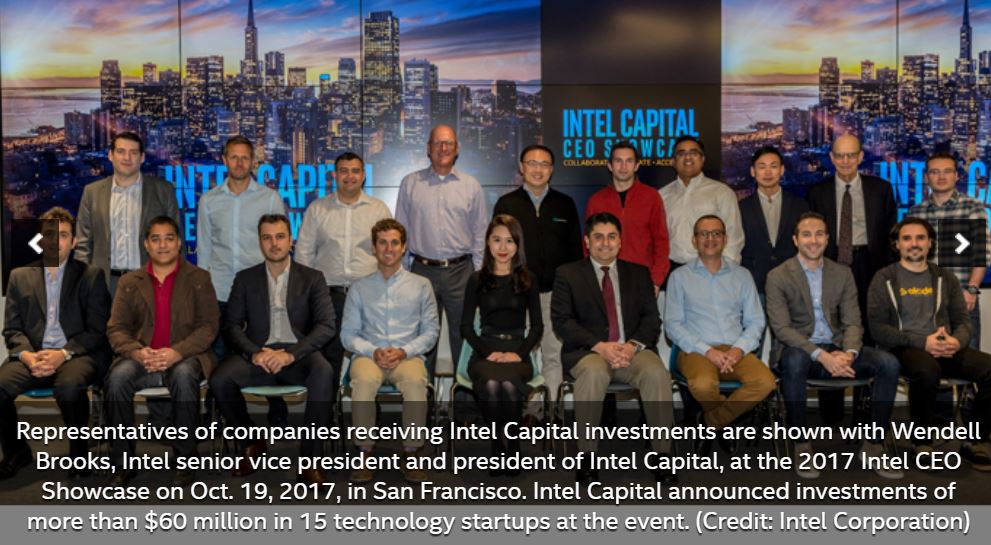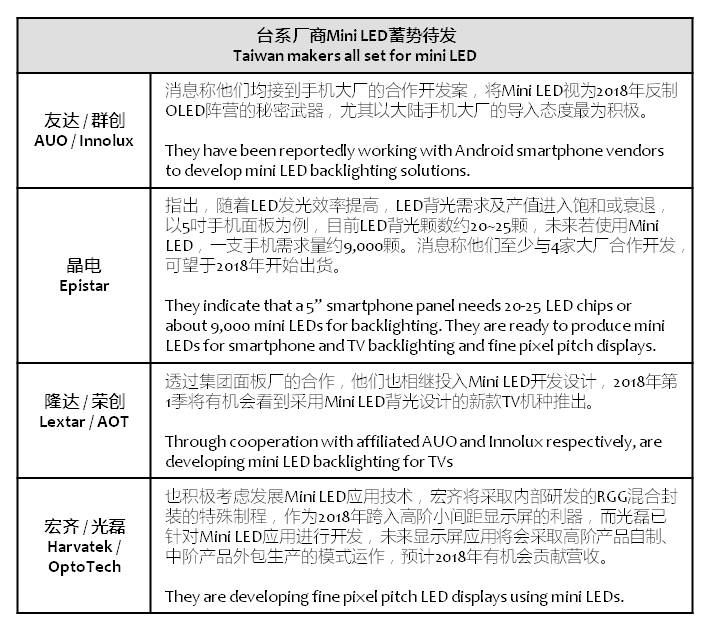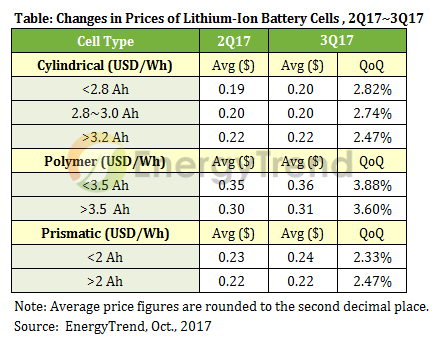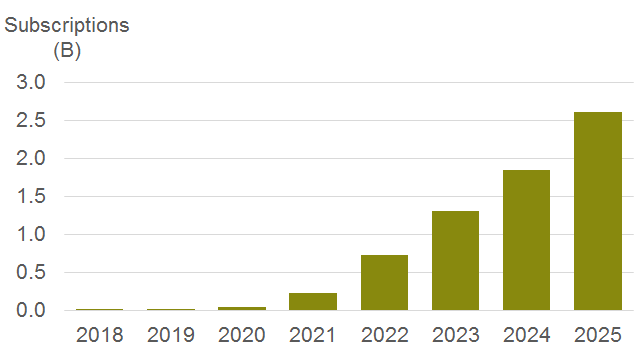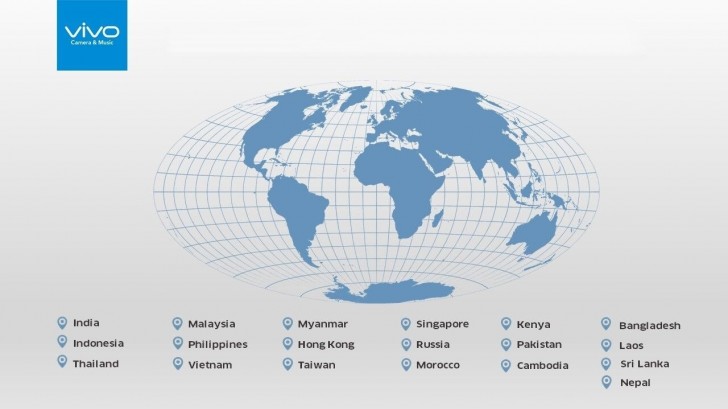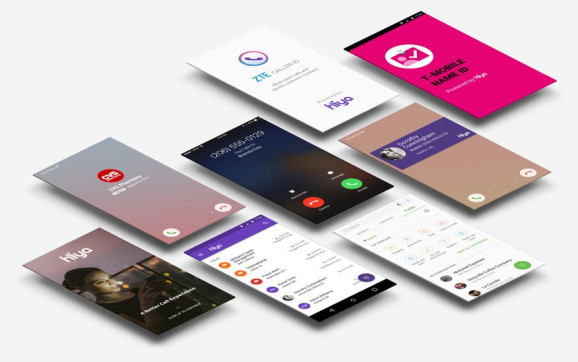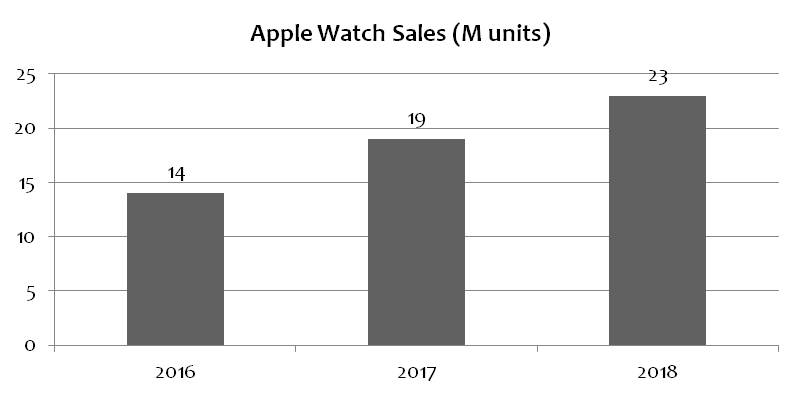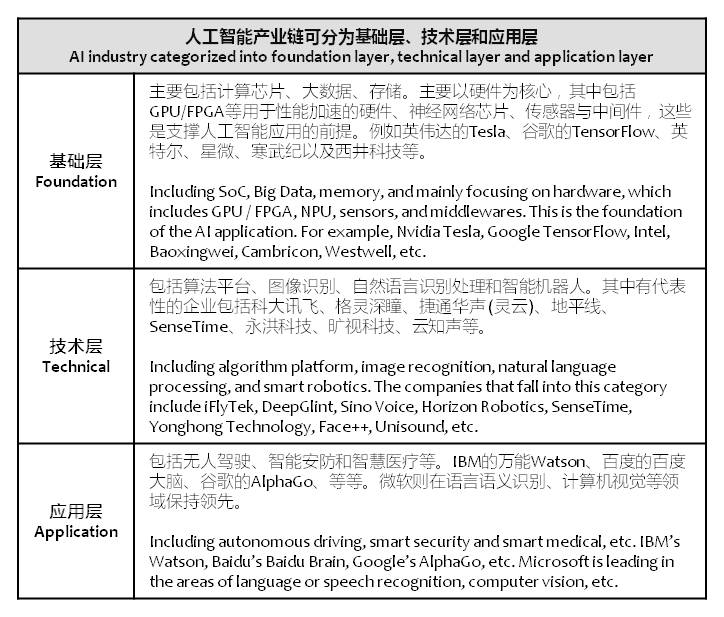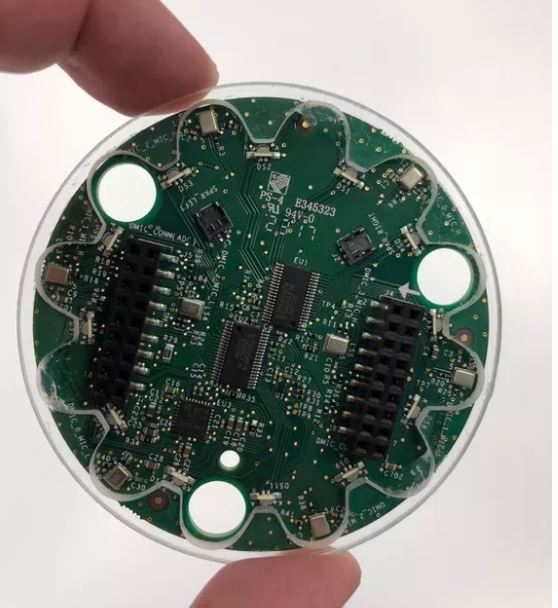
10-21: Huawei is working on a foldable phone, and already have a working sample; Global DRAM will be in tight-supply next year; vivo announces expansion to 6 new markets; etc.
Chipsets
IC Insights has raised its IC market growth rate forecast for 2017 to 22%, up 6% from the 16% increase shown in its Mid-Year Update. The IC unit volume shipment growth rate forecast has also been increased from 11% depicted in the Mid-Year Update to 14% currently. For 2017, IC Insights expects a whopping 77% increase in the DRAM ASP, which is forecast to propel the DRAM market to 74% growth this year, the largest growth rate since the 78% DRAM market increase in 1994. (Laoyaoba, IC Insights, press)
Qualcomm said its USD39B acquisition of NXP Semiconductors NV is on schedule to close by the end of 2017, paving the way for it to be a major player in autonomous driving. (Laoyaoba, Market Watch, WSJ, NASDAQ)
LG and Qualcomm have agreed to open a joint research lab in Seoul to develop a telecoms solution for autonomous driving, integrating LG’s strength in connected car parts and Qualcomm’s advanced communications chipset technology. (Android Headlines, Webwire, ABC News, Financial Times, TechNews)
TSMC co-executive Liu Deyin said that current 10nm process accounts for 10% of TSMC’s total wafer sales in 3Q17, and it will increase to 20% by 4Q17. By the end of 2018, TSMC’s 7nm process will accumulate at least 50 design-ins, half of which will come from high-performance computing (HPC) applications. (Laoyaoba, UDN, LTN, Malaysian Reserve)
Intel has unveiled a new development kit that aims to bring voice-control capabilities from Amazon Alexa to more third-party smart home devices. Intel said the Speech Enabling Developer Kit provides a complete audio front-end solution for far-field voice control. (The Inquirer, ZDNet, CNET, Engadget, Intel, Sina)
Intel Capital, Intel Corporation’s global investment organization, announced new investments totaling more than USD60M in 15 technology startups. The company introduced the CEOs and founders of the startups. This latest group of new portfolio companies brings Intel Capital’s year-to-date investing to more than USD566M. (Laoyaoba, Intel)
Touch Display
Taiwan-based LED firms, in view of tight supply of AMOLED smartphone panels and increasing competition in the LED backlighting segment from China-based makers, are ready adopt mini LEDs for TV and smartphone backlighting applications and fine pixel pitch displays, according to Digitimes. (Digitimes, press, EE World, Laoyaoba)
Richard Yu, CEO of Huawei’s consumer business group reveals that the company is working on a foldable phone, and already have a working sample—it has 2 screens, and have a small gap between the screens. (Gizmo China, GSM Arena, CNET, Liliputing, CN Beta)
Memory
TrendForce, forecasts that the global DRAM supply for 2018 will show an annual bit growth of just 19.6%, which is another low in recent years. The global top 3 major DRAM suppliers – Samsung, SK Hynix and Micron – are now in the midst of their capacity planning for 2018. All 3 suppliers tend to be conservative with regard to capital outlays in 2018. They have opted to slow down their capacity expansions and technology migrations so that they can keep 2018 prices at the same high level as during 2H17. TrendForce forecasts that the annual global DRAM bit demand for 2018 will grow by a larger margin of 20.6%. (EE Times, TechNews, Forbes, TrendForce, press, TrendForce[cn])
Battery
EnergyTrend, a division of TrendForce, finds that the price upswing for battery cells has started to moderate since 3Q17. Although the price of cobalt reached a new high for the recent years during 3Q17, prices of battery cells have been climbing more slowly after the large hikes in 2Q17. The overall price increase in the battery cell market is anticipated to be even smaller for 4Q17. In the market for batteries used in mobile phones, the polymer type’s representation in the total demand is projected to grow from 67% in the second quarter to around 70% in 3Q17. (TrendForce[cn], TrendForce, press)
Connectivity
According to CCS Insight, the forecast predicts that 5G connections will reach 1B worldwide in mid-2023, taking less time than 4G to reach this milestone. As early as 2022, China will account for more than half of all 5G subscribers. In the longer term, CCS Insight sees 5G adoption taking a broadly similar path to 4G LTE technology. Subscriptions to 5G networks will reach 2.6B in 2025, equivalent to more than 1 in every 5 mobile connections. (Android Headlines, CCS Insight, press, 199IT)
MIIT reveals that China’s 5G third phase trial will start in end of 2017, and in 2018 the related pre-commercialization usage will begin. China operators have invested about CNY1.13T in 5G base station infrastructure, which his more than 60% of the investment growth for 4G. (Laoyaoba, CN Beta, Huanqiu)
Intel has abandoned Project Alloy, a standalone VR headset, and believing WiGig wireless networking technology can connect a high-performance PC with a wireless virtual reality headset, providing a new option for doing VR without the annoying cables. The WiGig technology, which uses a short-range 60GHz radio, can transfer data at fast enough rates to feed VR imagery from a PC to the display in a VR headset. (Laoyaoba, VentureBeat, VR World)
Smartphones
Samsung Electronics is reportedly selling around 10K~20K units of the Galaxy Note 8 per day in South Korea. Samsung kicked off sales of the Galaxy Note 8 on 21 Sept 2017 after its preorders posted 850K units, far above predecessor, which gathered 400,000 early adopters. Strategy Analytics said Samsung Electronics is expected to sell 10M units of the Galaxy Note 8 by the end of 2017. (CN Beta, Laoyaoba, Yonhap News, Telecom Paper, Yonhap News)
vivo announces expansion to 6 new markets. vivo will appear “soon” in Taiwan, Singapore, and Hong Kong. It will also make its European debut by launching official sales in Russia. The company also declared a push to the African market with sales in Morocco and Kenya. (GSM Arena, Phone Radar)
Hiya, startup that makes mobile phone calls more contextual for millions of users, has raised USD18M in Series A funding to expand globally. The round was led by Balderton Capital, Europe’s leading early-stage venture investor, with participation from Nautilus Venture Partners and Lumia Capital. (Laoyaoba, PR Newswire, VentureBeat)
KeyBanc Capital Markets analyst Andy Hargreaves predicts that Apple’s fiscal 2018 iPhone average selling price and gross profit margin will be USD760 and 39.5%. (CN Beta, CNBC, Market Watch)
KGI Securities indicates that only 2M~3M units of Apple iPhone X will be shipped for sale before the launch on 3 Nov 2017. KGI has dropped estimates for initial 4Q17 shipments from 30M~35M to 25M~30M units. In 1Q18, though, KGI believes shipments could increase by as much as 50%. (GSM Arena, 9to5Mac, Laoyaoba, TechNews)
Wearables
GBH Insights analyst Daniel Ives called the Apple Watch Series 3 a “game changer release for Cupertino to open up this wearables category for the coming years.” Ives checked at Apple Stores and took surveys, and found that 70% of Apple Watch Series 3 buyers did not own the Series 1 or Series 2 product. (GBH Insights, press, Fortune, CNBC)
Internet of Things
China AI industry has formed an industry development alliance. The alliance will speed up the push of AI in manufacture, medical, service and city management applications. At the same time, the alliance will consolidate the supply chain resource, which can be categorized in foundation layer, technical layer and application layer. (Laoyaoba, Economic Information Daily)
Whirlpool and GE Appliances have asked a U.S. trade panel to recommend 50% import duties on large residential washing machines to ensure that rivals LG and Samsung follow through on plans to shift washer production to the United States. (CN Beta, Fox Business, Reuters)
Internet company Naver has unveiled its latest robotics and artificial intelligence technologies and said it was focusing research on transportation. Naver said it has been focusing on robotics research with the aim of developing autonomous cars, one of the hottest AI technologies. It is hoping to be able to road-test driverless cars by the end of 2017. (Asia Nikkei, The Investor, TechNews)
